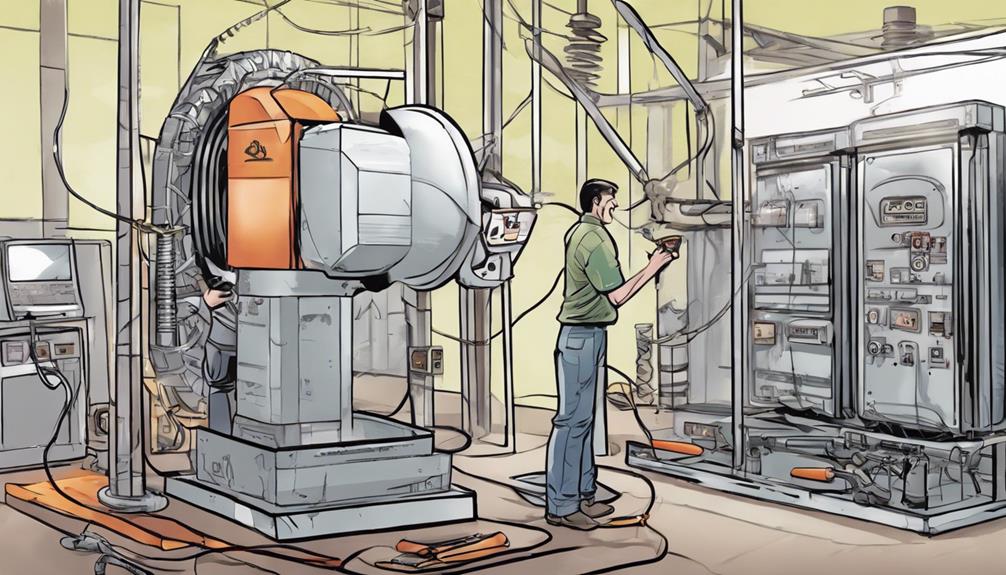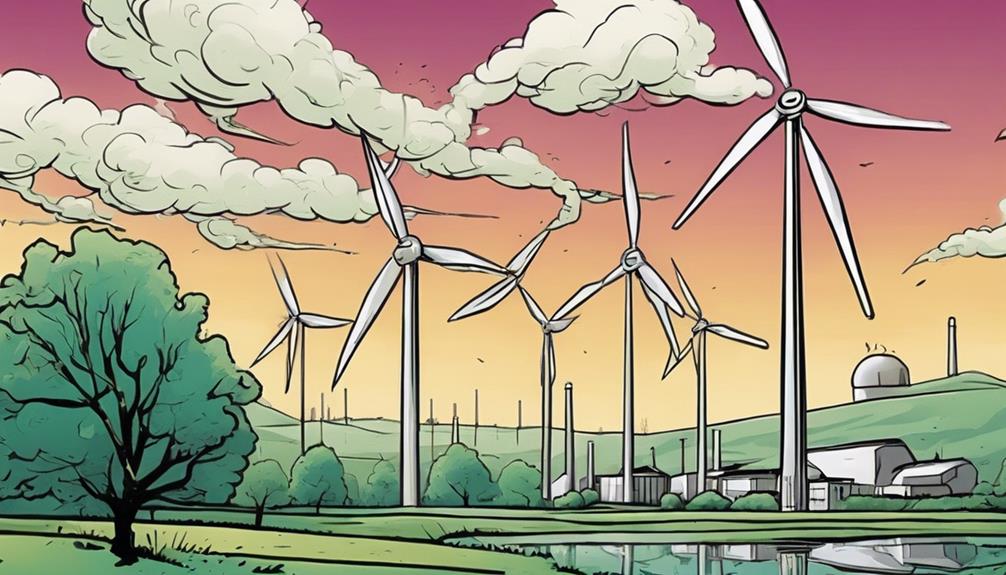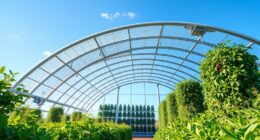You can generate enough electricity to power around 1,500 homes annually with a single wind turbine, producing over 6 million kWh of clean energy every year. The amount of electricity a wind turbine produces depends on its capacity, which typically ranges from 2-3 megawatts, and wind speed. As you explore the world of wind energy, you'll discover that larger turbines and consistent wind flow can significantly enhance electricity production. With the right conditions, a single turbine can produce up to 12 MW daily, making a substantial impact on the energy sector – and that's just the beginning of the story.
Key Takeaways
- A single wind turbine can generate around 6 million kWh of electricity annually, meeting the energy demands of 1,500 households.
- Turbines can produce between 172 to 11,300 kWh per day, depending on wind speed and turbine design.
- Modern horizontal-axis turbines can produce up to 12 MW per day, significantly contributing to the energy sector.
- Larger turbines with optimized blade design can capture more wind energy, resulting in higher electricity production.
- Wind speed directly impacts electricity production, with a 1 mph increase potentially boosting energy production by up to 3%.
How Do Wind Turbines Work
As you approach a wind turbine, you'll notice its blades starting to turn when the wind speed reaches a gentle 3-5 meters per second. This gentle breeze is enough to set the turbine in motion, converting the kinetic energy of the wind into something more useful – electricity.
The spinning motion of the blades turns a shaft in the nacelle of the turbine, which is the housing at the top of the tower. Inside the nacelle, a generator converts the kinetic energy from the spinning shaft into electrical energy. This energy is what we're after – it's what allows wind turbines to generate electricity.
The process is quite efficient, with the turbine's blades capturing the wind's kinetic energy and the generator converting it into a usable form. As the blades continue to spin, they generate more and more energy, making wind turbines a clean and sustainable way to produce electricity.
Power Production of Wind Turbines
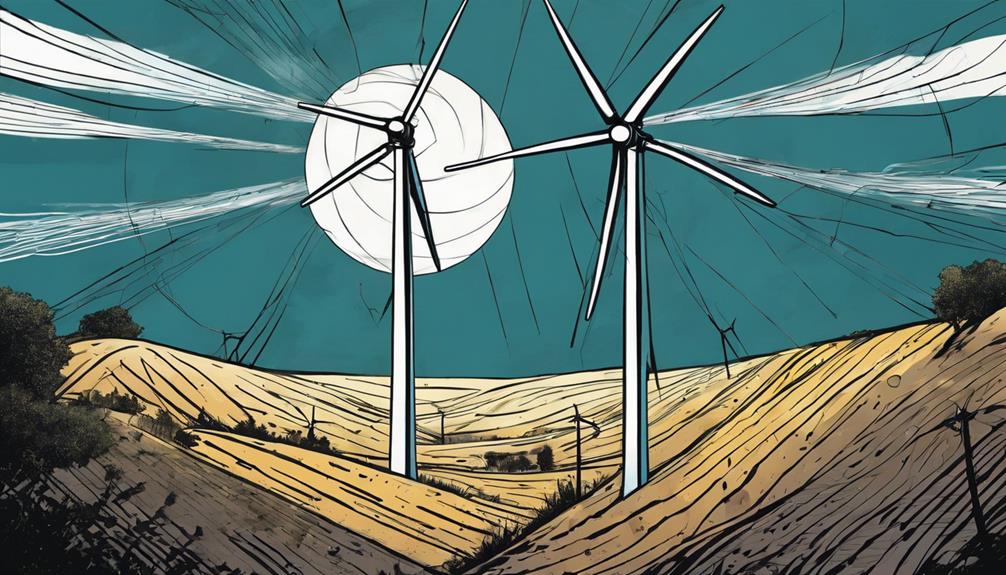
As you explore the power production of wind turbines, you'll want to know the capacity of a single turbine and how much electricity it can generate annually.
You'll discover that a typical onshore wind turbine can produce over 6 million kWh of electricity each year, which is enough to meet the energy demands of around 1,500 households.
Now, let's take a closer look at the key factors that influence a wind turbine's power production, including its capacity, annual output, and the impact on household electricity demand.
Wind Turbine Capacity
You can expect a typical onshore wind turbine to have a capacity of 2-3 megawatts, generating over 6 million kilowatt-hours of electricity annually, enough to power around 1,500 households for a year. This significant wind turbine capacity is vital in meeting the power demand of many homes.
The electricity generation of wind turbines largely depends on wind speed, making it essential to strategically locate them in areas with consistent winds. As a result, you'll often find wind farms in coastal or hilly regions with strong wind patterns.
The UK has seen rapid growth in its wind power capacity, with turbines now meeting the electricity demand of around 18 million homes. In fact, National Grid data reveals that over 26% of the UK's electricity comes from wind turbines.
Turbine Annual Production
On average, a single wind turbine produces over 6 million kilowatt-hours of electricity annually, which is enough to power around 1,500 households for a year. This turbine annual production is influenced by several factors, primarily wind speed. As you know, wind turbines are strategically placed in wind farms to maintain consistent and best wind conditions for efficient electricity generation.
The UK, for instance, has over 8,800 onshore and 2,300 offshore wind turbines, collectively meeting the electricity demand of 18 million homes.
You might wonder how wind speed affects electricity generation. Fundamentally, wind turbines are designed to operate at ideal levels when wind speeds range between 7-25 meters per second. This is why wind farms are located in areas with consistent wind patterns, such as coastal regions or mountaintops.
Household Electricity Demand
With an average wind turbine capable of powering around 1,500 households per year, it's natural to wonder what exactly goes into meeting the electricity demand of a single home. Your household's electricity demand is likely to vary depending on factors like the size of your home, the number of occupants, and your energy usage habits.
On average, a UK household consumes around 4,000 kWh of electricity annually. Meeting this demand requires a significant amount of electricity, which is where wind turbines come in. A single onshore wind turbine can produce over 6 million kWh of electricity annually, making it possible to power around 1,500 households.
UK's Wind Farm Abundance Reasons

The UK's unique geography, characterized by its breezy location, makes it an ideal location for harnessing wind energy. You'll notice an abundant wind farm presence in the UK, which is attributed to its breezy location, perfect for wind power generation. Wind energy is a reliable renewable source in the UK, meeting peak electricity demands especially during winter. The UK's strategic location allows for efficient utilization of both offshore and onshore wind energy resources. Building wind farms in the UK has a low carbon footprint, contributing to sustainable energy production.
As you explore the UK's wind energy landscape, you'll realize that wind turbines collectively meet the electricity demand of approximately 18 million homes. This showcases their significant impact on the energy sector. The UK's abundant wind farm presence is a statement of its commitment to renewable energy. With wind energy being a reliable and sustainable source, it's no wonder the UK has become a hub for wind power generation.
You'll find that the UK's breezy position has created an ideal environment for harnessing wind energy, making it an attractive location for wind farm development.
Electricity Generation From Wind

As you explore the world of wind turbine electricity production, you're likely wondering how much power these turbines can actually generate. Traditional wind turbines can generate anywhere from 1.5 to 3 MW of power, with larger commercial turbines producing up to 8 MW. The amount of power generated depends on the size of the turbine and the wind speed at the location. In order to optimize efficiency and power output, engineers are constantly researching and developing new wind turbine blade materials. These materials need to be strong and lightweight in order to withstand the force of the wind while also being cost-effective to produce.
Let's take a closer look at the key factors that influence electricity generation from wind, including wind power output, turbine capacity factors, and energy production rates.
Wind Power Output
You can rely on a single wind turbine to produce a significant amount of electricity annually, around 6 million kWh, which is enough to power approximately 1,500 households. This is an important contribution to the overall energy mix, especially considering that wind turbines produce electricity when wind speeds reach 6-9 mph and operate at maximum efficiency between 30-55 mph.
On average, a turbine can generate much electricity per day, making them an essential source of renewable energy. In fact, the collective output of wind turbines in the UK is impressive, with over 8,800 onshore and 2,300 offshore turbines generating a substantial amount of electricity. This is evident in the National Grid data, which shows that over 26% of the UK's electricity comes from wind turbines.
As a result, wind power has become a significant component of the UK's energy mix, meeting the demand of approximately 18 million homes.
Turbine Capacity Factors
Wind turbines' ability to generate electricity efficiently depends on their performance factors, which typically range from 25% to 45% and are influenced by factors like wind speed, turbine size, and maintenance.
You might wonder, what does this performance factor represent? It's the actual electricity generated compared to the maximum potential.
Here are three key factors that affect a turbine's performance factor:
- Wind speed: Turbines operate at their best at certain wind speeds. If the wind is too slow or too fast, electricity production suffers.
- Turbine size: Larger turbines can harness more wind energy, leading to a higher performance factor.
- Maintenance: Regular upkeep ensures turbines run smoothly, maximizing electricity production and performance factor.
High-performance factor wind turbines can generate electricity more consistently and efficiently, contributing to a higher overall energy output. By understanding and improving performance factors, you can enhance the effectiveness and sustainability of wind energy generation.
Regular maintenance and efficient turbine design are essential for maximizing performance factors and electricity production. By optimizing these factors, you can increase the efficiency of your wind turbines and produce more electricity.
Energy Production Rates
Six million kilowatt-hours of electricity per year – enough to power around 1,500 homes – is the impressive annual production capacity of a single, well-functioning wind turbine. But what drives this energy production? The answer lies in wind speeds. As you'd expect, higher wind speeds lead to increased energy production. In fact, a mere 1 mph increase in average wind speed can boost energy production by up to 3%.
Here's a breakdown of how wind speeds impact energy production:
| Wind Speed (mph) | Energy Production (kWh/year) |
|---|---|
| 7 | 3,000,000 |
| 8 | 4,000,000 |
| 9 | 5,500,000 |
| 10 | 7,000,000 |
| 11 | 9,000,000 |
As you can see, even small increases in wind speed have a significant impact on energy production. With over 8,800 onshore and 2,300 offshore wind turbines in the UK, it's no wonder wind power plays an essential role in the country's energy mix and sustainability efforts. By understanding how wind speeds affect energy production, you can appreciate the substantial contribution wind turbines make to the national grid.
Number of Wind Turbines in UK
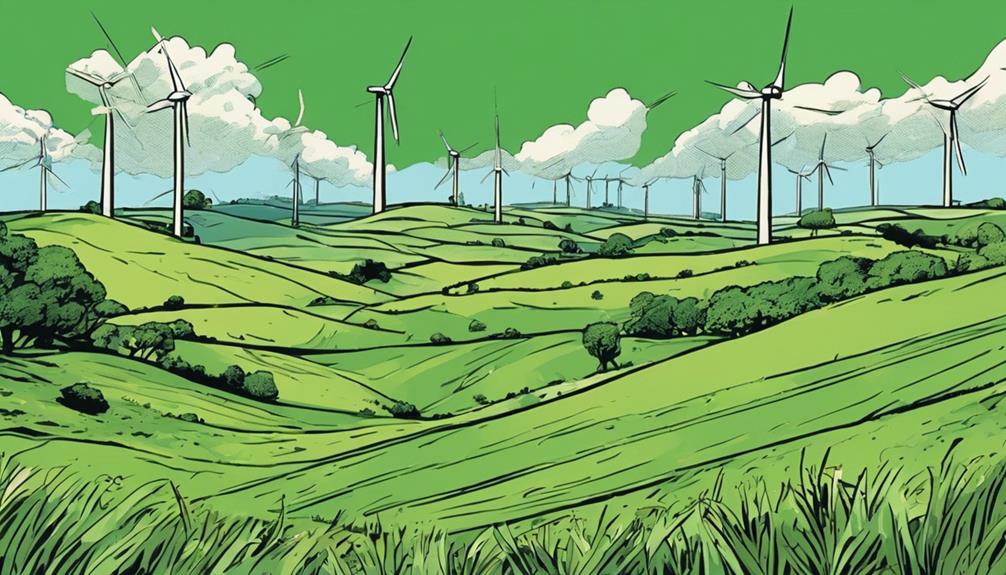
Roughly 11,100 wind turbines, comprising 8,800 onshore and 2,300 offshore units, currently operate in the UK. As you explore the wind industry, you'll find that this number is significant not only for the UK but also in comparison to other countries. For instance, the United States has a larger number of onshore wind turbines, but the UK's offshore capacity is substantial.
Here are some key facts about the UK's wind turbines:
- 8,800 onshore wind turbines generate electricity for millions of homes.
- 2,300 offshore wind turbines harness the power of the sea to produce clean energy.
- Collectively, they meet the electricity demand of 18 million homes in the UK.
The UK's commitment to Renewable Energy is evident in the growth of its wind industry. As you explore further into the world of wind turbines, you'll discover that the UK is a leader in harnessing wind power to reduce its carbon footprint. The number of wind turbines and their capacity continue to increase, making a substantial contribution to the UK's energy mix.
Average Energy Output of Turbines
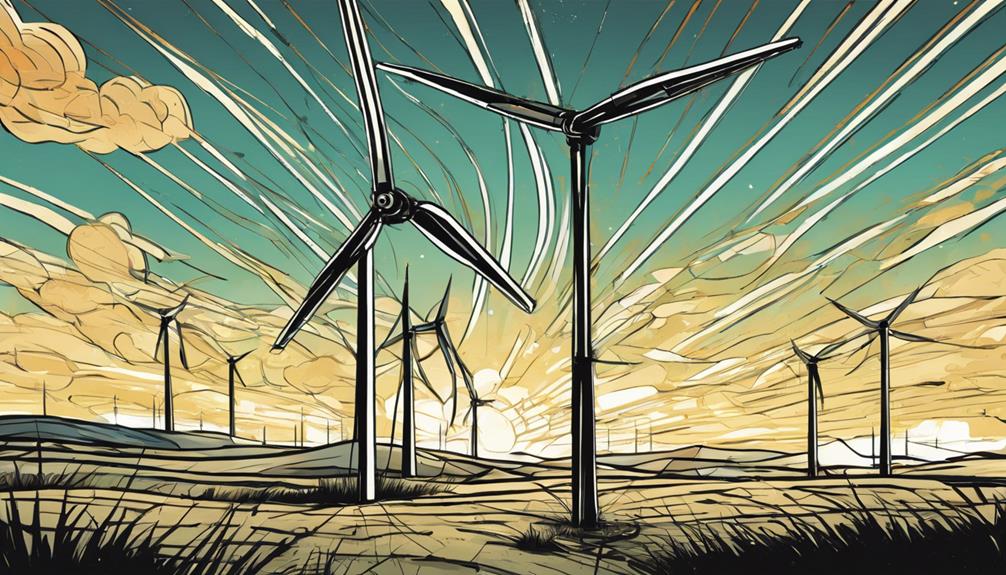
You'll find that the energy output of a wind turbine varies greatly depending on its size, location, and model. There are two main types of wind turbines: horizontal-axis turbines (HAWTs) and vertical-axis turbines (VAWTs). Within each type, different models offer varying levels of efficiency and energy production.
On average, a single HAWT can produce approximately 26.1 megawatts (MW) per day. However, wind turbines can generate anywhere from 172 to 11,300 kilowatt-hours (kWh) per day, depending on the type and size.
When it comes to average energy output, you'll notice that HAWTs tend to outperform VAWTs. This is due to their design, which allows them to capture wind energy more efficiently. As you explore different models, you'll find that some boast higher efficiency levels than others.
For instance, some modern HAWTs can produce up to 12 MW per day, while smaller VAWTs might only produce around 1 kW per day. Understanding the average energy output of different wind turbines is essential in determining which one is right for your needs.
Factors Affecting Energy Production

As you consider the average energy output of different wind turbines, it's clear that various factors come into play to influence their performance, and understanding these factors is vital to maximizing electricity production.
To generate electricity efficiently, wind turbines rely on specific conditions. Here are three key factors that affect energy production:
- Wind speed:
Consistent and strong wind flow is vital for maximizing energy generation from a wind turbine. Higher wind speeds result in increased electricity production, while low or inconsistent winds can reduce output.
- Air density:
The density of the air also plays a role in energy production, as it affects the turbine's ability to generate power.
- Blade size and design:
The size and design of the turbine blades play an important role in determining the amount of energy a wind turbine can produce.
Energy Production Per Year Explained

When you consider the annual energy production of a single wind turbine, it's crucial to think that it can generate around 6 million kWh of electricity, enough to power approximately 1,500 households. This energy output is a result of various factors coming together, including wind speed, turbine size, and location.
The size of the turbine, in particular, plays a significant role in determining its energy output. A larger turbine can capture more wind energy, resulting in a higher energy production.
Wind speed is another vital factor that affects the energy production of a turbine. As wind speed increases, the turbine's energy output also increases. In ideal conditions, a single turbine can produce a substantial amount of electricity. However, it's important to note that the actual energy production may vary depending on the location and environmental conditions.
On a larger scale, wind farms comprising multiple turbines can generate up to 300,000 MW of electricity per year, making them a significant contributor to the overall energy mix. By understanding the energy production of a single turbine, you can appreciate the significant impact that wind energy can have on our daily lives.
Size and Location Impact Production
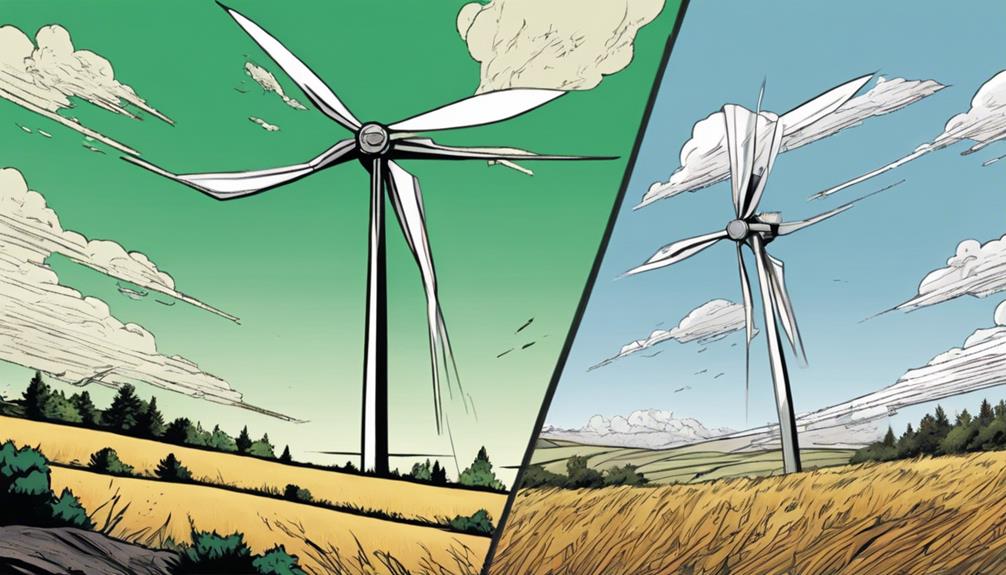
As you explore the world of wind turbine electricity production, you'll discover that the size of the turbine and its location play an essential role in determining its energy output.
You'll learn that larger turbines can generate more electricity, and that turbines placed in areas with strong, consistent winds can maximize their production.
Now, let's take a closer look at how turbine size, wind speed, and location impact electricity production.
Turbine Size Matters
You'll get more electricity from a larger wind turbine with higher capacity, which makes it a critical factor in deciding the right size for your needs. The turbine size directly impacts electricity production, and it's crucial to keep this in mind when selecting a turbine for your project.
Here are three key takeaways to bear in mind:
- Larger turbines produce more electricity: With higher capacity, larger turbines can generate more power, making them ideal for large-scale projects or areas with high energy demands.
- Location affects production: The location of your wind turbine, whether onshore or offshore, significantly influences electricity production. Offshore turbines typically benefit from higher wind speeds, leading to increased electricity output.
- Size and location work together: The size of your turbine and the wind conditions at your location work in tandem to determine your electricity output. A larger turbine in a location with strong, consistent winds will produce more electricity than a smaller turbine in a low-wind area.
Wind Speed Impacts Output
Wind speed is the most vital factor in determining your turbine's electricity production, with even minor fluctuations greatly affecting output. You'll need wind speeds of at least 6-9 mph for your turbine to start generating electricity.
As wind speeds increase, so does your turbine's output – but only up to a certain level. If wind speeds exceed 55 mph, your turbine will shut down to prevent damage.
The optimal wind speed range for maximum electricity production varies depending on the turbine design, but generally falls between 25-35 mph. At these speeds, your turbine's efficiency peaks, and you'll generate the most electricity.
However, even small changes in wind speed can have a significant impact on your turbine's output. For example, a 1 mph increase in wind speed can enhance electricity production by up to 3%.
Properly sizing and placing your wind turbine is essential to maximizing its electricity production. By considering local wind speed patterns and turbine design, you can optimize your turbine's performance and get the most out of your investment.
Location Affects Energy Production
Your wind turbine's location and size play a significant role in determining its electricity production, and optimizing these factors can greatly impact your energy output.
When it comes to location, you want to place your turbine in an area with high wind speeds, as this will directly affect energy production. Here are three key location factors to take into account:
- Wind speeds: Turbines in locations with higher wind speeds can produce more electricity. That's why offshore wind turbines, which typically have higher wind speeds and less turbulence, tend to be more efficient.
- Turbulence: Avoid placing your turbine in areas with high turbulence, as this can reduce energy production and even damage the turbine.
- Proximity to demand: Locating your turbine near areas of high energy demand can reduce transmission losses and increase efficiency.
Environmental Benefits and Challenges

By harnessing the power of wind, we're reducing our reliance on fossil fuels and mitigating the devastating impact of climate change. As you consider the environmental benefits of wind energy, you'll find that it's a clean and renewable power source that helps reduce greenhouse gas emissions. Wind turbines have a lower carbon footprint compared to traditional fossil fuel-based energy sources, making them an important component in the renewable energy sector.
Nevertheless, as you explore further, you'll also encounter challenges associated with wind energy. For instance, wind turbines can potentially impact wildlife, generate noise pollution, and affect visual aesthetics. It's vital to acknowledge these challenges and continue researching and developing solutions to address them.
Despite these hurdles, wind energy contributes to energy independence and job creation in the renewable energy sector. By embracing wind power, you're supporting a cleaner, more sustainable future. As you weigh the environmental benefits and challenges, remember that wind energy is an integral step towards reducing our reliance on fossil fuels and mitigating climate change.
Frequently Asked Questions
How Much Electricity Does a Wind Turbine Produce per Day?
You're wondering how much electricity a wind turbine produces per day – well, it varies greatly, but expect around 172 kWh to 11,300 kWh, depending on the turbine's size, type, and wind speed, with HAWTs being the most efficient.
How Many Homes Does 1 Wind Turbine Power?
You're wondering how many homes one wind turbine powers? Well, it can power around 300 homes annually, depending on its size, location, and wind conditions, making a significant impact on your community's energy needs.
How Long Does It Take for a Wind Turbine to Pay for Itself?
You're wondering how long it takes for a wind turbine to pay for itself, like a student waiting for grades. On average, it'll take you around 6 to 30 months, depending on wind speed and energy prices, to break even on your investment.
How Big of a Wind Turbine Is Needed to Power a House?
You'll need a wind turbine sized right for your home's energy needs and local wind speeds; a 5-15 kW turbine could be perfect, but it depends on your usage and wind conditions, so assess those first.
Conclusion
As you've seen, wind turbines are an impressive source of renewable energy.
But here's the fascinating part: did you know that a single wind turbine can power over 1,400 homes annually?
That's equivalent to reducing carbon emissions by 2,200 tons!
It's no wonder the UK is investing heavily in wind farms.
With the right location and size, these turbines can generate a substantial amount of electricity, making them an essential step towards a cleaner, greener future.





